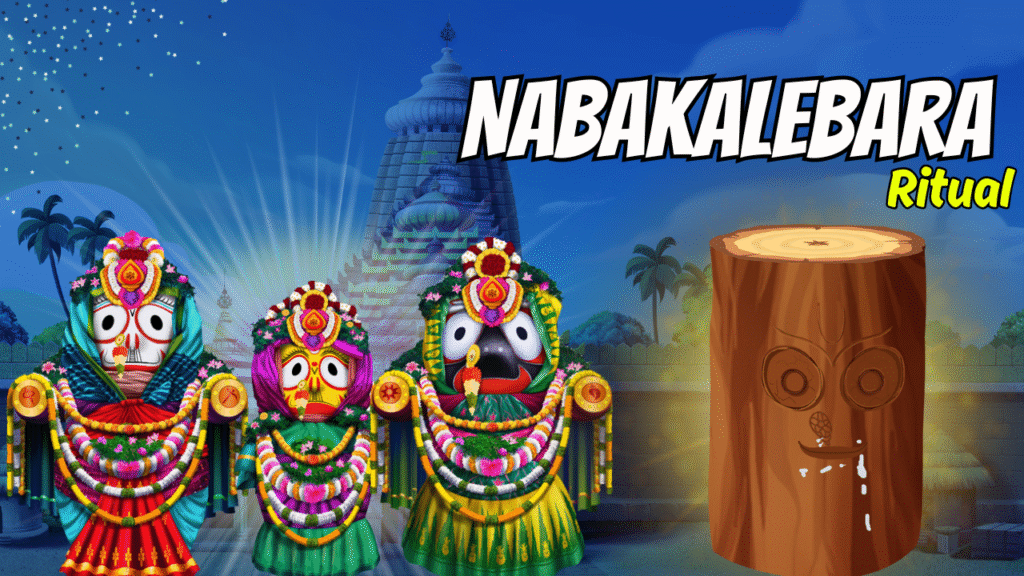
The Nabakalebara Ritual: When the Lord Changes His Body
A Divine Rebirth Like No Other
The Nabakalebara Ritual, In most traditions, the idea of death and rebirth is reserved for mortals. But in Puri, Odisha, even God changes His body. This profound and sacred ritual is called Nabakalebara, meaning “new embodiment”.
It is a rare and powerful event when Lord Jagannath, Balabhadra, Subhadra, and Sudarshan relinquish their old wooden forms and are reborn in new ones — a mystical ceremony of divine transition that only takes place once every 12 to 19 years, depending on the lunar calendar.
This is not just a ritual, but a spiritual phenomenon filled with secrecy, symbolism, and centuries-old tradition.

What is Nabakalebara?
Nabakalebara is a sacred process in which the wooden idols (Darubrahma) of the deities at the Jagannath Temple are replaced with new ones, symbolizing death, rebirth, and the cycle of life — even for the Supreme Being.
This event is deeply philosophical, illustrating that even God takes new form when time calls, but the “Brahma” or soul never changes.
When Does It Happen?
The Nabakalebara Ritual takes place during a year that has two Ashadha months (called Adhikmasa) in the Hindu lunar calendar, which happens every 12–19 years.
The last Nabakalebara occurred in 2015, and the next is expected in the 2030s, based on astrological cycles.
The Sacred Search: Finding the Daru (Neem Trees)
One of the most mystical parts of the ritual is the search for the sacred Neem trees, known as Daru. But these aren’t just any trees — they must meet divine signs:
-
Found near a water body
-
No bird nests or marks on them
-
Presence of symbols like a chakra, conch, or plow on the bark
-
Surrounded by serene, spiritually vibrant surroundings
This search is led by a team of temple priests and servitors, called Banajaga Yatra, who receive signs through dreams and meditative insights.
Once identified, the trees are worshipped like gods, cut down with rituals, and brought to Puri with immense reverence.
Carving the New Deities: A Sacred Secret
Once the Daru reaches Koili Baikuntha (a secret garden within the temple), highly skilled carvers from a specific lineage begin sculpting the new idols.
Key facts:
-
The work is done in complete secrecy.
-
No one except authorized servitors can witness the process.
-
The “Brahma Padartha” (soul substance) from the old idols is transferred to the new ones in a ritual performed at midnight.
-
Once the transfer is complete, the old idols are ceremoniously buried in Koili Baikuntha.
This is the only known ritual in the world where God is said to die, be reborn, and be reinstalled with full consciousness.
Spiritual Significance
Nabakalebara teaches a profound lesson — forms may change, but the soul is eternal. It connects us to the cycles of life and the idea that even divinity is bound by cosmic rhythm and time.
It’s a reminder that change is not destruction, but transformation — a divine renewal.
Millions Come to Witness This Once-in-a-Lifetime Event
During Nabakalebara, Puri transforms into a spiritual epicenter. Millions of devotees gather from around the world to witness the rare rebirth of the Lord, especially during the Rath Yatra, where the newly carved idols are taken out in grand procession for public darshan.
Hotels overflow, trains are packed, and yet the spiritual energy keeps flowing. For many, witnessing Nabakalebara even once is the blessing of a lifetime.
A Ritual Beyond Time and Logic
Nabakalebara is not merely a festival or a tradition — it’s a divine occurrence that blends ritual, philosophy, mystery, and devotion. It reminds humanity that even the eternal chooses to evolve.
At Puri, death is not an end for the Lord — it is a passage to new life, just as it is for all beings. And in that, Lord Jagannath becomes one with the people — not just as God, but as a soul that walks the same journey.


Leave a reply here
Your email address will not be published. Required fields are marked *